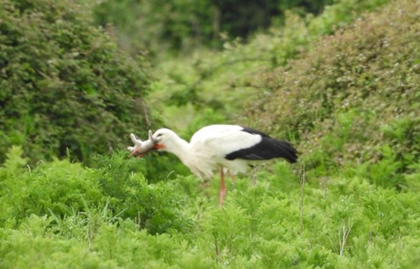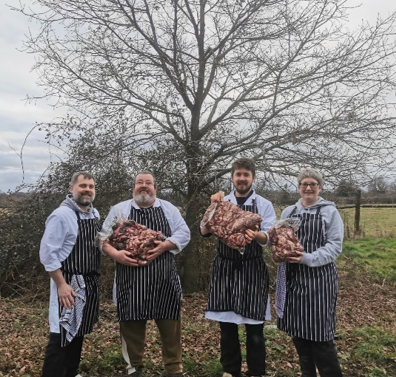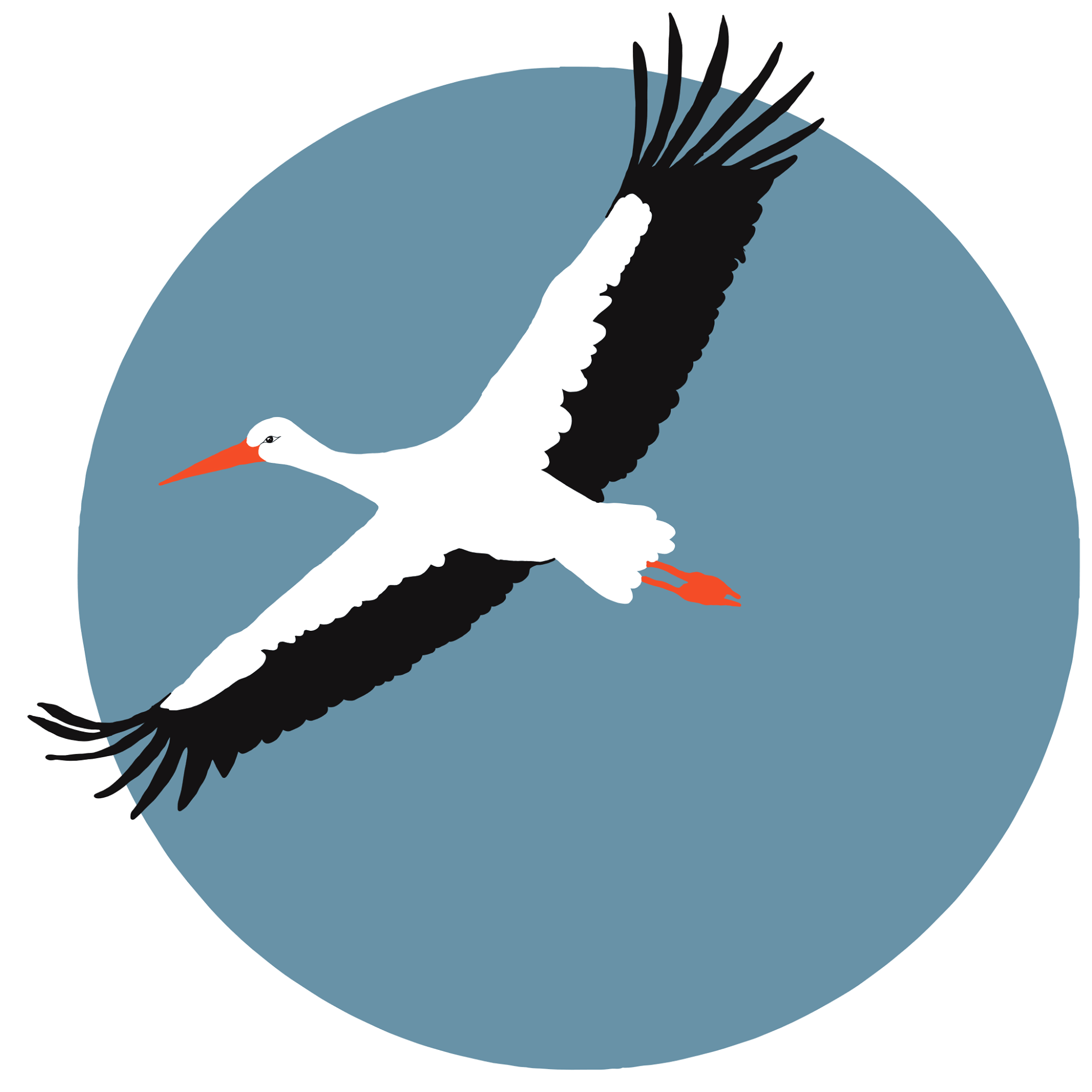News
White Stork Diet and Supplementary FeedingWhite storks are opportunistic carnivores with a broad range of prey and watching them foraging is a fascinating pastime.
By far the greatest proportion of their diet comes from earthworms – particularly in winter when the ground is soft – and insects. With remarkable precision, they use their long, straight, pointed beaks to pick tiny morsels such as beetles less than a centimetre long from between grass stems.
Their fantastic eyesight and lightning reactions allow them to home in on grasshoppers, crane flies, moths and butterflies as they rise up from the ground in front of them.

A stork eating a young rabbit (Andy Taylor, Knepp 2022)
Kicking through the grassland at Knepp on their long legs, storks can spend hours each day collecting insects, ingesting them whole. Unlike many birds they also have a keen sense of smell, originating in a large olfactory bulb in the brain which contains numerous receptor molecules for scents. Researchers at the Max Planck Institute for Animal Behaviour in Radolfzell and the Max Planck Institute for Chemistry in Mainz, Germany, have proved that storks are attracted by the smell of mown grass, having learnt to associate mown areas with easy pickings of snails, small mammals and frogs. They can sense the smell of cut grass from 25 kms away.
Conversely, they can also gulp down items much larger than would appear comfortable, up to the size of a baby rabbit. They will also occasionally take frogs and small fish, though the proportion of ‘wet’ food to dry remains low.
Across Europe and north Africa where white storks overwinter, their opportunistic and unfussy approach to food is an advantage as they can make use of land fill sites to forage on. On some sites, storks are found in the thousands, picking through litter to find protein in the form of restaurant or household food waste, or raw meat from the poultry industry.

A stork forages for invertebrates amongst grass (camera trap, Knepp 2023)
Landscape recovery for storks, and all species
A key aspect of the White Stork Project is working with surrounding landowners to encourage land management practices that provide good habitat and food for storks. For example, maintaining field margins increases populations of insects and small mammals, retaining areas of wetland encourages amphibian and aquatic populations, and creating pastures which are rich in earthworms. Of course, all these practises will benefit a wide range of other species too. The Weald to Waves project encapsulates these ideas by aiming for a 100-mile nature corridor based along the Arun, Adur and Ouse river catchments in Sussex which prioritises the quality of habitats which will support all species, including the white stork.

The rehabilitated bird above with a damaged left wing is, like its non-flying companions, kept safe in a predator proof pen. (Camera trap – Knepp 2023)
Supplementary Feeding
Improving surrounding habitat is a vital aspect of the project which will serve the growing stork colony long term. However, we also have previously injured, rehabilitated birds to consider. These storks are an important aspect of the project. They are kept safe in a large, predator-proof pen on site at Knepp which consists of mixed habitat including woodland, grassland, and a pond with surrounding wetland, providing a significant amount of natural forage.
They are non-flying because they have suffered injuries from collision with electricity pylons, traffic accidents and the like that have left them with only one wing, or wings that don’t fully function. Many of them were given to the project by Warsaw Zoo in Poland where they were treated and rehabilitated. Some of these storks now reside in the pen at Knepp and a pen at our partner site, Wadhurst in East Sussex, while others are part of the project’s breeding programme in a large enclosure at Cotswold Wildlife Park in Oxfordshire.
As well as being able to carry out natural behaviours in a lovely environment, crucially, these non-flying storks at Knepp and Wadhurst are also acting as ‘magnets’, drawing in wild storks adventuring over from Europe. Thanks largely to the attraction of these two penned ‘colonies’, wild birds are already beginning to nest and breed with the project’s free-flying juveniles – offspring of the non-fliers – in the surrounding area. We hope it will only be a question of time before we see the first wild bird breeding with a non-flier in one of the pens.
To ensure the non-flying birds are getting an adequate diet, we supplementary feed them each day. Our wonderful volunteer team work hard to ensure the storks are fed and they observe them every day to check their health. We provide them with different sources of protein to ensure they are getting a high quality and varied diet. This can include appropriate roadkill, day-old chicks (a by-product of the poultry industry and an important resource for zoos) or fish.
We try to ensure this food is as sustainable and local as possible. At Knepp, the on-site butchery processes Wild Range meat from the red and fallow deer, longhorn cattle and Tamworth pigs from the rewilding project. These animals have led a free-range and organic life and the meat they produce is nutritionally dense.
Any fat, gristle, cartilage, or organs that cannot be used in the Wilding Kitchen’s nose-to-tail café and restaurant or sold in the shop is now being used as stork food. This is a fantastic resource for our storks, particularly in the run-up to breeding season, and we are very grateful to the team at the butchery for taking the time to process and package it for us every week.
Ian Mepham who leads the butchery team says, ‘It’s incredibly satisfying to know that every scrap of waste from our beautiful meat is going to feed Knepp’s storks. There’s a lovely synchronicity to it – the kind of holistic, closed-loop thinking where one aspect of the rewilding project is actively supporting another.’

The Knepp Wild Range butchery team holding off-cuts set aside for the storks.
